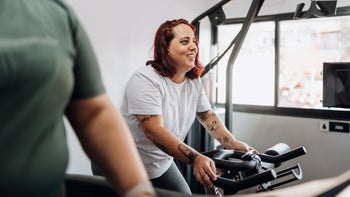
8 Warm-Up Exercises to Prevent Injury and Maximize Your Workout
Key takeaways:
An effective warm-up should be dynamic, with light cardio or active stretches.
Examples of dynamic warm-up exercises include jumping jacks, lunges, and bodyweight squats.
A 5- to 10-minute warm-up before every workout can help prevent injury and improve exercise performance.
When you hit the gym or lace up your sneakers for a workout, you're likely raring to go. Maybe you're excited to start your training. Or perhaps you just want to get it over with.
Whatever the case, slow down. Jumping right into exercise without a proper warm-up, including light-intensity cardio and mobility exercises, is a common mistake. And it can have some negative consequences, like an increased risk of injury.
But don't worry. Doing a few warm-up exercises doesn't take much time, and it can improve your workout performance.
Search and compare options
What are the best warm-up exercises?
A proper warm-up should only take you about 5 to 10 minutes. That's enough time to get your blood flowing and increase the range of motion in your joints.
Static stretches –– which you hold for brief periods –– used to be the go-to for warm-ups. But research shows that dynamic exercises are more effective before a workout. Dynamic movements include light cardio and active stretches that mimic the activity you plan to do.
So choose warm-up exercises that engage the muscle groups you'll use the most during your workout. For example, if you're preparing for a tennis match, working your shoulders and legs with arm circles and side shuffles will get you in game mode.
Here are several effective warm-up exercises to choose from based on your workout.
1. Jumping jacks
Jumping jacks are a great way to prepare for aerobic and strength-training workouts. The total-body exercise increases your heart rate and gets your blood flowing.
Step 1: Stand with your arms at your sides and your feet shoulder- to hip-distance apart. Keep a slight bend in your knees and your feet pointing forward.
Step 2: Bend your knees as you jump your feet out to either side of your body. Try to land softly and maintain the slight bend in the knees.
Step 3: As you jump, raise your arms out to the sides and over your head.
Step 4: Reverse the move by jumping and bringing your feet back to starting position while lowering your arms to your sides.
Step 5: Repeat at a moderate to fast pace for 30 to 90 seconds.
Read more like this
Explore these related articles, suggested for readers like you.
2. Shoulder rolls
Shoulder rolls loosen your upper back and shoulder muscles. They also open your chest and help you prepare for upper-body exercises.
Step 1: Stand with your back straight, your feet shoulder-width apart, and your arms straight at your sides.
Step 2: Gently rotate your shoulders in a circular motion. Shrug your shoulders toward your ears, then shift them forward, down, and back.
Step 3: Work through your full range of motion at a controlled pace. Keep your back straight throughout each rotation.
Step 4: Complete 5 to 10 repetitions, then switch directions.
3. Arm swings
You can also warm up your upper body –– including your arms, shoulders, upper back, and chest –– with arm swings.
Step 1: Stand tall with your feet shoulder-width apart and your arms at your sides.
Step 2: Raise your arms out to the side at shoulder level, with your palms facing the floor.
Step 3: Pull your arms back gently, moving your shoulder blades together as you open your chest. Then swing your arms in front of you, crossing your right arm over your left.
Step 4: Repeat for 30 to 60 seconds, using your entire range of motion and alternating between crossing your right arm over your left and your left arm over your right.
4. High knees
Think of high knees as a supercharged version of running in place. The exercise gets your heart pumping as you engage your core and lower-body muscles.
Step 1: Stand upright with your feet hip-distance apart and your arms at your sides.
Step 2: Engage your core and lift your right leg, bringing your knee toward your chest.
Step 3: Return your right foot to the ground and immediately lift your left leg, bringing your knee toward your chest. Swing your arms back and forth as if you're running.
Step 4: Pick up the pace to a jogging or running speed so that you're quickly hopping from one foot to the other and powerfully raising your leg to your chest.
Step 5: Continue for 30- to 60-second intervals.
5. Mountain climbers
You can work multiple upper and lower-body muscle groups –– such as the arms, core, and quadriceps –– with mountain climbers.
Step 1: Start face-down on the floor in a plank position with your shoulders aligned over your wrists. Keep your back flat and your core muscles engaged as you support your weight with your palms and toes touching the floor.
Step 2: Bend your right knee and pull it into your chest as far as possible, then return your right foot to the starting position.
Step 3: Repeat the movement on your left side.
Step 4: Now, pick up the pace to a jogging speed, quickly switching legs.
6. Squats
Squats are a go-to bodyweight exercise for a reason. The functional exercise activates the core and lower-body muscles, including the glutes, quads, hamstrings, and calves.
Step 1: Stand with your feet slightly wider than hip-distance apart, your toes turned out slightly, and your arms by your sides.
Step 2: Pull your shoulders back and down to open your chest.
Step 3: Engage your core and bend your knees as you shift your weight back and down.
Step 4: Squat down as low as you can while keeping your knees behind your toes and your spine neutral.
Step 5: Press into your feet and reverse the movement, returning to the starting position.
Step 6: Repeat 10 to 15 times.
7. Lunges
Like squats, lunges are a functional exercise that can strengthen the glutes, quads, hamstrings, and calves. The move may also boost your athletic performance.
Step 1: Stand with your feet together and arms at your sides. Keep your shoulders down and back and contract your core muscles. Maintain this upright posture in your upper body throughout the movement.
Step 2: Take a big step forward with your right foot, landing gently and bending both knees as you land.
Step 3: Lower down until your right knee is at a 90-degree angle.
Step 4: Push through your right foot to draw your leg back to the starting position.
Step 5: Switch sides, lunging forward with your left foot.
Step 6: Continue to alternate, doing 10 to 15 repetitions on each side.
8. Side lunges
Side lunges include a different range of motion that also engages the inner and outer thigh muscles. And they can help correct muscle imbalances in your legs.
Step 1: Stand with your feet together and arms at your sides. Pull your shoulders back and down and tighten your core muscles.
Step 2: Take a large step out to the right, landing gently on your right foot as you bend your right knee.
Step 3: Push your hips out and back but maintain an upright posture in your chest and spine. Lower down so your right knee is as close to a right angle as possible.
Step 4: Press through your right foot to rise back up and return to your starting position.
Step 5: Repeat the movement on the left side.
Step 6: Continue to alternate sides, completing 10 to 15 reps on each leg.
What are the benefits of a warm-up?
A warm-up helps you ease into exercise, preparing your body and mind for more vigorous activity. A proper warm-up can:
Increase blood flow and muscle temperature: A dynamic warm-up helps get blood flowing to your muscles, bringing a fresh supply of oxygen to fuel your exercise. The gradual rise in body temperature increases muscle temperature, which enhances flexibility and mobility.
Improve range of motion: Increased range of motion helps you move easily, reduces pain, and prevents injury — while exercising and in your everyday life. The heat and gentle stress of a dynamic warm-up produce a thixotropic effect, which helps muscles and tendons move more fluidly.
Reduce the risk of injury: Warming up primes your muscles and joints for exercise. This can help reduce the risk of exercise-induced injuries such as sprains and strains.
Increase psychological readiness for exercise: Not only does a warm-up prime your body, but it also helps you prepare mentally for the challenge ahead. In a 2018 study, athletes who performed a warm-up reported higher psychological readiness.
Boost exercise performance: These benefits may enhance your exercise performance. One study found that a dynamic warm-up was more effective than a heavy-load warm-up strategy in elite tennis players. Those who did an active warm-up had better sprint performance, agility, countermovement jumps, and hip flexor mobility.
The bottom line
A 5- to 10-minute warm-up before exercise is critical to your fitness plan. Doing so can help prevent injury, boost workout performance, and help you prepare mentally for exercise. Include dynamic warm-up exercises, such as jumping jacks and active stretches, that target the muscles you'll use during your workout.
Why trust our experts?



References
American Council on Exercise. (n.d.). Bodyweight squat.
American Council on Exercise. (n.d.). Forward lunge.
American Council on Exercise. (n.d.). Mountain climbers.
American Council on Exercise. (n.d.). Plank-ups.
American Council on Exercise. (n.d.). Side lunge.
American Heart Association. (2014). Warm up, cool down.
Behm, D. G., et al. (2011). A review of the acute effects of static and dynamic stretching on performance. European Journal of Applied Physiology.
Behm, D. G. (2018). Mechanisms underlying acute changes in range of motion. The Science and Physiology of Flexibility and Stretching.
Haley, J. (n.d.). The importance of flexibility and mobility. PennState Kinesiology.
Moreno-Pérez, V., et al. (2021). Post-activation performance enhancement of dynamic stretching and heavy load warm-up strategies in elite tennis players. Journal of Back and Musculoskeletal Rehabilitation.
Okobi, O. E., et al. (2022). A meta-analysis of randomized controlled trials on the effectiveness of exercise intervention in preventing sports injuries. Curēus.
Park, H. K., et al. (2018). The effect of warm-ups with stretching on the isokinetic moments of collegiate men. Journal of Exercise Rehabilitation.




























